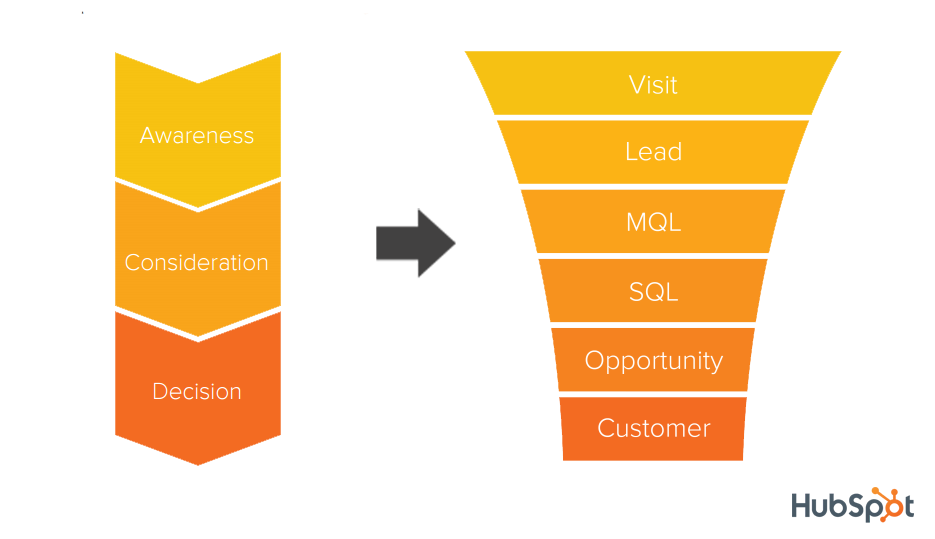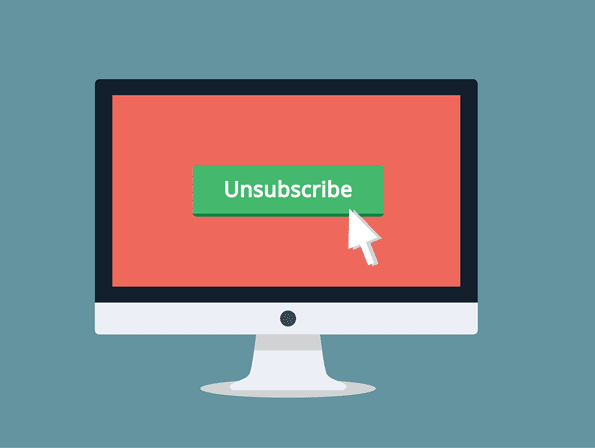It is important to be able to quickly evaluate, categorize, and qualify your contacts in HubSpot to efficiently use the tool. Lead scoring can help you accomplish this and serves to keep your data actionable and organized, whether you have a team of users or a HubSpot wizard of 1.
What is Lead Scoring?
Lead scoring is the practice of "scoring" leads, or contacts, in an effort to describe and identify best-fit leads.
It relies on using qualifying characteristics and information to score contacts and this results in a quantitative score that is attributed to the contact.
What information should you include in lead scoring?
As mentioned above, lead scoring uses contact data and information to attribute a numerical score for the contact record.
This data and characteristics can be qualitative or quantitative in nature, as long as it is important to categorizing, evaluating, and taking action with your leads.
Lead Scoring markers essentially boil down to what information is attributed to your best-fit clients and customers, making contacts with the same attributes valuable to prospect to.
This can also be described as your Ideal Client Profile.
What is an Ideal Client Profile
An Ideal Client Profile, otherwise referred to as ICP, is a group of characteristics that best describes your clients or customers. These are the people, or entities, that would most benefit from your products or services.
How to Create an Ideal Client Profile
The Process
When evaluating who your Ideal Client Profile might be you should start by referring to your most successful case studies and customer relationships.
If you have been using HubSpot, you should review your Deals Closed-Won for commonalities and recurring themes.
Do your Closed-Won deals belong to certain industries or company sizes?
Are there certain job roles or titles that are the most beneficial to prospect?
These are the types of questions you should ask yourself to identify what information you should be including in your lead scoring models. Next, we'll break down the different categories of information and data to consider when developing your lead scoring model.
Data Types to Evaluate and Possibly Include
Company Information
- Examples:
- Company Size
- Industry Type
- B2B or B2C
Demographic Information
- Examples include:
- Contact Information
- Geographic Location
- Job Title/Stakeholder Information
- Tip: Use your past deal records and positive case studies to inform what information to include here. This is highly variable and will depend heavily on what past successes have looked like or where current goals are set. You can also leverage the insights within your team, specifically, the sales team and their qualitative feedback from their conversations and experiences.
Engagement and Behavioral Information
- Email/Social, including:
- Opens
- Clicks
- Downloads
Contacts who are frequently interacting and engaging with your content are showing positive indicators of interest and should be positively attributed in the lead score.
- Page Interaction and Views:
- Are they frequently viewing your pages and visiting your site?
- Consent and Permissions:
- Are they subscribed to your marketing newsletters or product updates?
Lead Scoring Best Practices
- Avoid using too large of values within your lead scoring model. This can be confusing and hard to understand quickly if the total score value is too large. For a general rule try to keep your values to 100 or less so end users can easily understand a contact's score.
- Let history inform your choices. As much as we like to trust our intuition, be sure to reference historical deal, contact, and company data when evaluating your past successes and failures. This will help identify which data is essential to the score model.
- Leverage your team's qualitative data. While quantitative data is essential as well, there is a great deal of value in speaking and gathering thoughts and observations from your team. Sales and Customer Service or Success teams work with contacts most directly in many cases and can offer valuable insights into what does and does not work.
- Don't be afraid to use negative score attributes in your lead scoring model. While it is best to use them sparingly and with intention, negative score attributes, much like positive score attributes should be tied to your specific Ideal Client Profile. In some cases is can be valuable to deduct score points to include what your Ideal Client Profile is not. For example, you may want to deduct points when a contact is unsubscribed or has marked your communications as spam.
How to set up Lead Scoring in HubSpot
The Lead Score Property in HubSpot
The "HubSpot Score" is the default HubSpot-provided scoring property. You have a default of 100 filters to utilize within your scoring model to be used for positive and negative scoring filters.
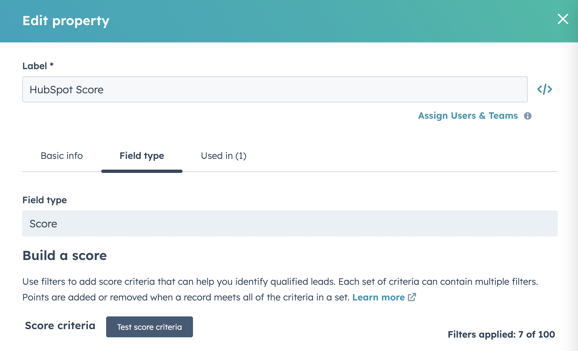
Creating a Score Property in HubSpot
The scoring criteria works very similarly to enrollment criteria or filters within a workflow or list, and essentially all filters within HubSpot. This makes navigating the criteria and adding filters much easier. 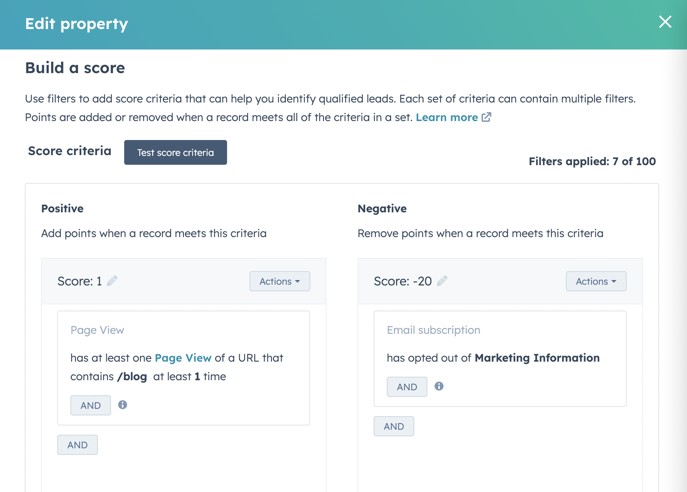 You can also clone an action which makes adding new but similar filter criteria a simpler process.
You can also clone an action which makes adding new but similar filter criteria a simpler process.
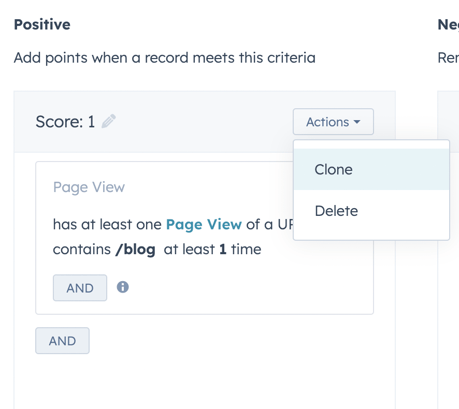 Maybe the most helpful and impactful function within the score property is the ability to test the criteria. This is very helpful for multiple reasons. Primarily, this allows you to validate the scoring criteria before it is deployed and used in any further segmentation, lead qualification, or outreach efforts.
Maybe the most helpful and impactful function within the score property is the ability to test the criteria. This is very helpful for multiple reasons. Primarily, this allows you to validate the scoring criteria before it is deployed and used in any further segmentation, lead qualification, or outreach efforts.
You may have a contact that you know to be your Ideal Client Profile, use this contact to test. If the score is not what you would expect it to be for your ICP, then reevaluate and identify any gaps or errors in the logic of the score model.
Alternatively, you may want to use a contact that is a poor lead fit for the same testing purpose.
Your lead scoring criteria should be reviewed and tested often to ensure it is still proving accurate and valuable for your team.
In summary
Lead scoring in HubSpot is highly customizable and can serve as an actionable tool for your team.
It should be informed by your company's history, your successes and failures, and validated by the qualitative data that your team can provide.
Getting the right lead scoring model in place can take time and thorough evaluation but is well worth the effort in the streamlined segmentation, lead qualification, and insight it can provide for your company's communication and outreach strategies spanning across marketing and sales functions.





